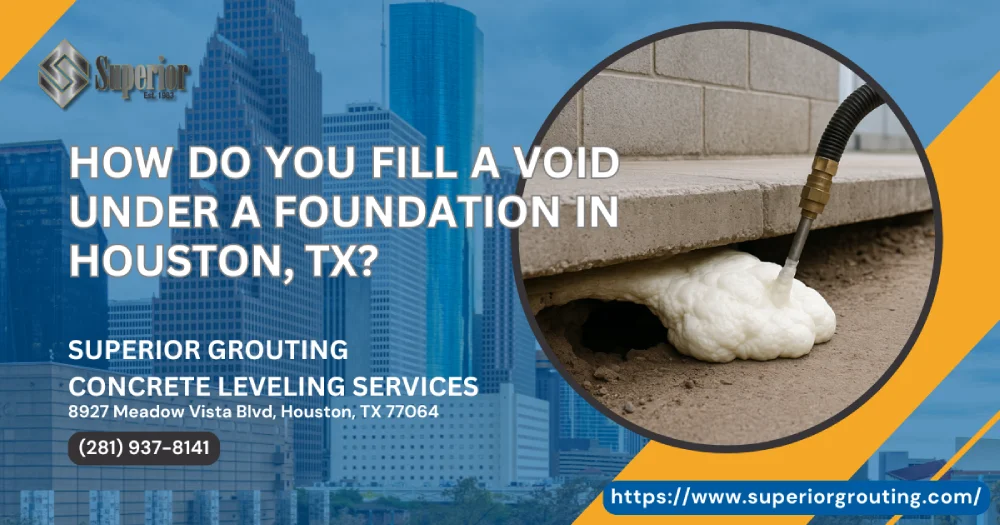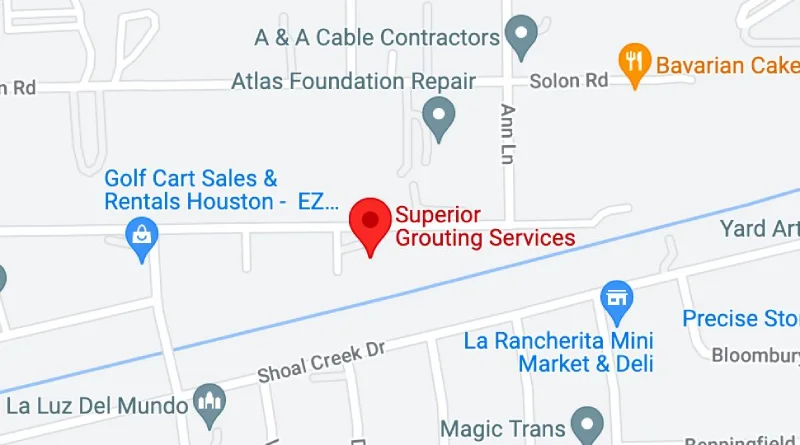How Do You Fill A Void Under A Foundation in Houston, TX?

Industrial facilities, treatment plants, and other large‐scale construction projects in Houston rely on solid ground support to keep production schedules on track. When a subsurface void appears beneath a concrete foundation, the risks range from misaligned equipment to severe structural integrity issues. Below, you’ll find a detailed look at why voids form, which grouting solutions are most effective, and how a qualified grouting contractor restores the bearing capacity of your slab while controlling groundwater and preventing seepage.
Key Takeaways
- Void filling restores foundation stability and load-bearing strength, using high-pressure grouting methods like polyurethane, cement, or chemical injection to eliminate air gaps, seal joints, and prevent further subsurface deterioration.
- Polyurethane grouting offers fast-curing, low-weight void filling, making it ideal for industrial slabs where downtime is costly and soil conditions demand rapid lift with minimal structural disruption.
- Cement pressure grouting is a cost-effective bulk fill, perfect for larger voids under treatment plants or shaft slabs, delivering compressive strength and resistance to buoyant groundwater forces.
- Chemical grouting excels at groundwater control, penetrating soft, unconsolidated soils with low-viscosity formulations that create an impermeable in-situ barrier—essential near active utility corridors and directional bore paths.
- Houston contractors rely on expert investigation and real-time monitoring, using radar, pressure gauges, and lift tracking to ensure safe, targeted injection that protects nearby structures and avoids hydraulic fracturing.
Grouting Fundamentals and Why They Matter
Grouting involves injecting a flowable material—chemical, cement‐based, or polyurethane—into unconsolidated or weak soil to stabilize, fill voids, and reduce permeability. Although tunnel grouting, jet grouting, and contact grouting along the tunnel liner are usually linked with underground transit or microtunneling, the same high-pressure injection principles work brilliantly for shallow foundations that demand immediate load recovery.
Common Causes of Voids in Houston
- Groundwater flow scours fine particles from underneath slabs, especially near water and sewer pipelines.
- Expansive clay soils shrink during drought, creating annular space between the slab and subgrade.
- Vibration from TBM launch pits, shaft construction, or heavy forklift traffic rearranges soil particles and forms cavities.
- Utility excavations that weren’t backfilled or compacted to spec settle over time.
Whether the void is under a tunnel boring machine launch pad or beneath a manufacturing line, early detection and rapid soil stabilization are critical to avoid costly downtime.
Comparing Major Void-Filling Methods
Houston owners typically choose between three grouting systems:
| Method | Material | Ideal Void Size | Cure Time | Key Benefits |
| Polyurethane Injection | Closed-cell foam | Small–medium | Minutes | Lightweight, water resistant, minimal drill pattern |
| Cement Pressure Grouting | Cement grout | Medium–large | 1–2 days | Economical bulk fill, high compressive strength |
| Chemical Grouting | Sodium silicate or acrylic | Thin seams, high permeability | Hours | Low viscosity, excellent groundwater control |
Each grouting method can be adapted to site-specific ground conditions. For example, high‐pressure jet grouting spins a cement-soil slurry in-situ to create solid columns that double as ground support for shafts or large diameter pipelines; meanwhile, low-mobility grout is used to fill annular space left by trenchless pipe ramming.
Polyurethane High-Pressure Injection
- Expands up to 30× its liquid volume, allowing contractors to inject modest amounts that travel far through the subsurface.
- Hydrophobic properties block water intrusion and cut off seepage paths.
- Because the foam is lighter than cement, it won’t overburden soft ground or weak soil.
Cementitious Pressure Grouting
- A pump forces a sand-cement mix design into the void until refusal.
- The heavier mass can counteract uplift from buoyant groundwater during dewatering.
- Compatible with existing structures that need a strong, rigid backfill.
Chemical Grouting for Groundwater Control
- Ultra-low viscosity chemical grouts permeate loose sand to reduce permeability and control groundwater.
- Often paired with tunnel excavation or shaft work where earth pressure must be balanced.
Step-By-Step: How a Houston Contractor Fills Foundation Voids
- Investigation: Ground-penetrating radar, core drill samples, and in-situ permeability tests define void geometry and water flow paths. Engineers review nearby excavation records, directional boring logs, and pipeline drawings to understand areas nearby that may influence grout take.
- Mix Design & Grouting Plan: Selecting chemical and cement ratios depends on subsurface viscosity, groundwater pressure, and required compressive strength. High pressure versus low pressure pumping strategies are chosen to avoid hydraulic fracturing of the slab.
- Drilling & Port Installation: Crews drill ⅝"–2" holes in a grid. Ports are lag-bolted or jack-anchored to handle injection forces.
- Injection & Monitoring: Real-time lasers and dial gauges track lift under critical equipment footings. Pump operators stage the grout so earth pressure equalizes without over-topping grade.
- Verification & Patching: Contact grouting confirms the annular space is completely filled. Thermal imaging and probe rods verify no residual voids remain. Holes are patched with rapid-set cement grout or epoxy for industrial-grade durability.
- Documentation: A full grouting work report details volumes, pressures, and final elevations—vital for asset management and warranty tracking.
Selecting the Right Grouting Contractor
The Gulf Coast is saturated with specialty contractors, but not all offer the same range of grouting services. Vet candidates with these points:
- Experience with high-pressure tunnel grouting, shaft stabilization, and wastewater treatment plant foundations.
- Ownership of advanced grouting pumps capable of 600–1,000 psi for deep injection.
- In-house geotechnical engineers who understand soil conditions such as soft ground, unconsolidated sand, and high‐permeability zones.
- Safety records for confined‐space entry when work occurs in shafts or utility galleries.
- A portfolio that includes microtunneling, trenchless pipeline projects, and directional drilling breakouts where grouting is used to control groundwater.
Cost Drivers in Industrial Void-Filling
- Grout Volume & Mix Design: Chemical grouts cost more per gallon but penetrate farther into low-permeability soil.
- Access Constraints: Working beneath a live pipeline rack may require remote-controlled rigs, increasing labor.
- Water Pressure & Dewatering: High groundwater levels raise pumping pressure and grout take.
- Operational Downtime: Minute-by-minute shutdown costs often justify premium polyurethane solutions that cure in under an hour.
Typical budgets run \$3–\$12 per square foot; however, complex tunnel liner contact grouting or large diameter shaft stabilization can exceed those figures.
Environmental and Operational Benefits
- Ground stabilization protects existing structures against settlement and water infiltration.
- Chemical and cement grouting systems reduce seepage, improving groundwater quality and preventing contamination at industrial and wastewater sites.
- Quick return-to-service minimizes production impacts, especially in facilities handling critical water and sewer utilities.
Conclusion
For Houston assets ranging from TBM launch chambers to expansive production slabs, voids aren’t just empty space—they’re a direct threat to uptime, safety, and long-term performance. By selecting the correct grouting solutions—polyurethane, cement-based, or chemical—and partnering with a seasoned grouting contractor, you regain structural integrity, control groundwater, and keep construction schedules intact. Early action prevents small gaps from becoming major failures, ensuring your facility’s foundation remains as dependable as the operations it supports.


